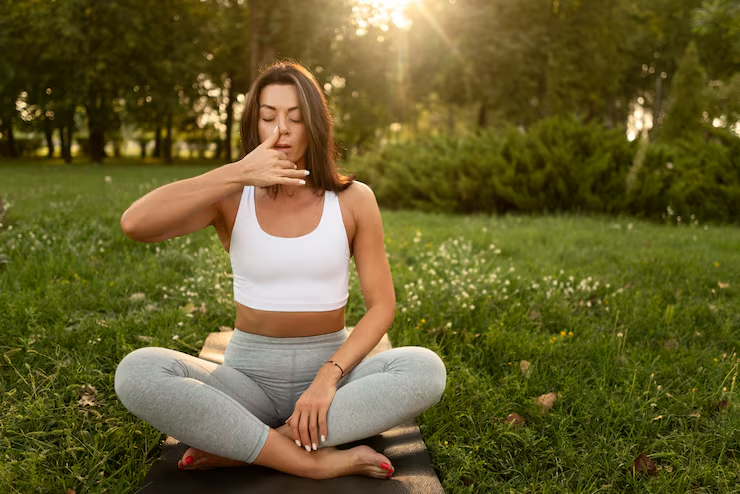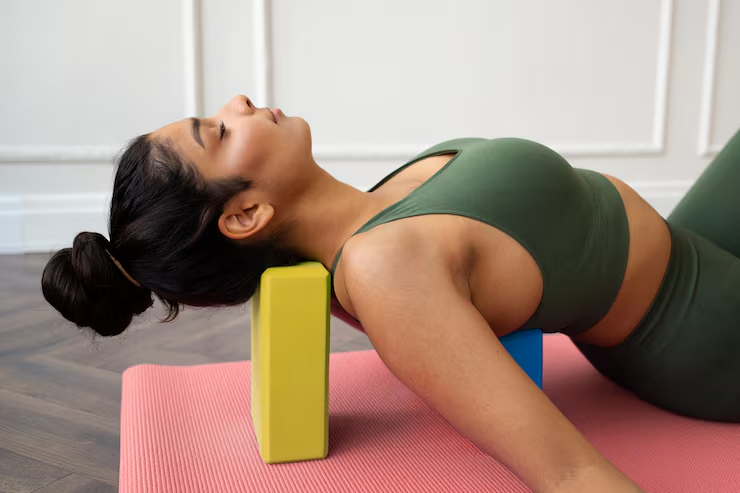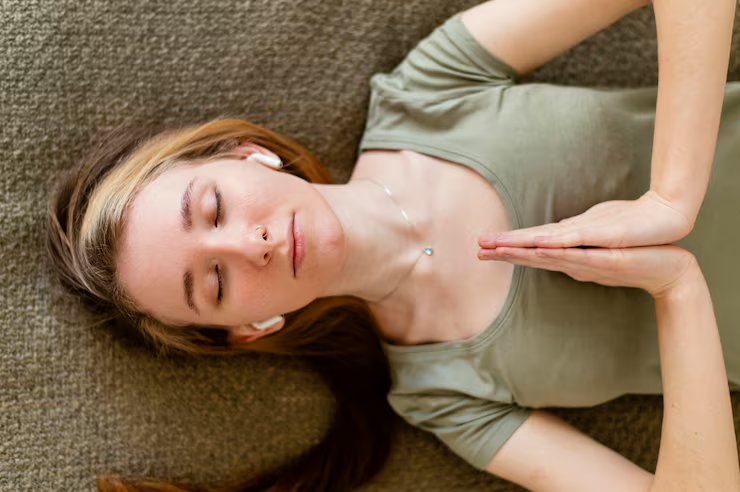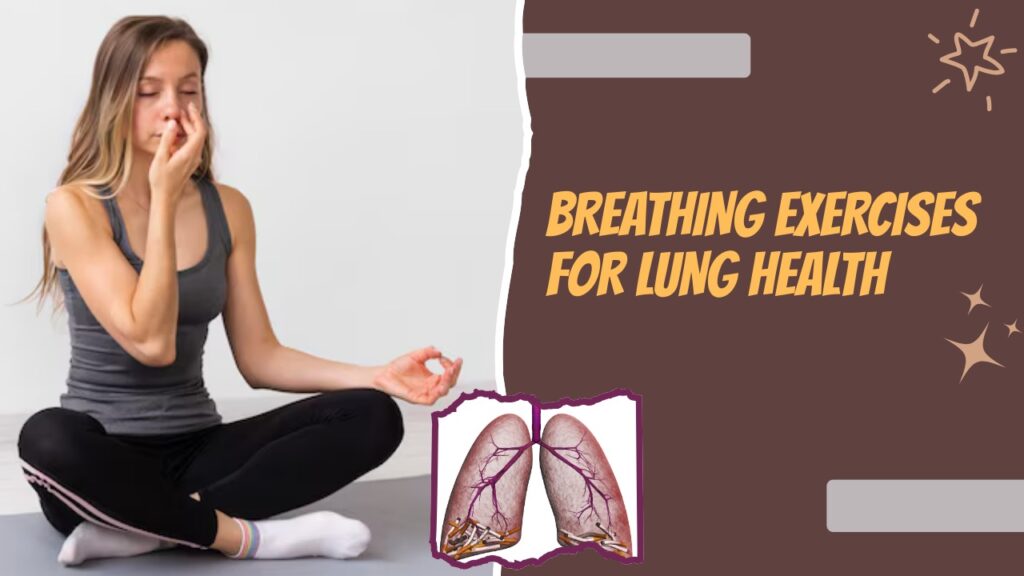Beginning breathing exercises for lung health is a simple yet powerful step toward improving your overall wellness. You don’t need special equipment—just a quiet space and a few minutes each day. Start by sitting or lying down in a comfortable position and focusing on your breath. The goal is to become aware of your breathing patterns and gradually take deeper, more controlled breaths.
One of the easiest exercises to begin with is diaphragmatic breathing (also known as belly breathing). Place one hand on your chest and the other on your abdomen. Inhale slowly through your nose, allowing your belly to rise while keeping your chest still. Then exhale gently through your mouth. Repeat for 5–10 minutes daily to build lung strength and improve airflow.
Consistency is key. As your lungs get stronger, you can add more advanced techniques like pursed-lip breathing or box breathing. These exercises promote relaxation, improve oxygen exchange, and support long-term lung health.
Why Lung Health Matters

Lung health is essential for maintaining energy, focus, and overall physical performance. Our lungs supply oxygen to every cell in the body, making them critical for survival and well-being. When lungs function properly, we feel more energized and capable of handling daily tasks with ease. Poor lung health, on the other hand, can lead to fatigue, shortness of breath, and decreased quality of life.
Maintaining strong lungs becomes even more important with age or in the presence of respiratory conditions like asthma, bronchitis, or COPD. One effective, natural way to support respiratory wellness is through breathing exercises for lung health. These exercises help clear mucus, increase lung capacity, and improve the efficiency of oxygen exchange in the body.
including breathing exercises for lung health into your daily routine can reduce stress, enhance sleep quality, and boost immunity. Whether you’re healthy or recovering, taking care of your lungs ensures a healthier, more vibrant life.
Your lungs are vital for delivering oxygen to your bloodstream and removing carbon dioxide. When your lungs function at full capacity, your energy levels increase, your immune system strengthens, and your mind feels clearer.
Unfortunately, due to factors like pollution, sedentary lifestyles, smoking, and chronic illnesses such as asthma or COPD, lung efficiency can decline. That’s where breathing exercises come in—they help restore, preserve, and enhance lung function naturally.
What Are Breathing Exercises?
Breathing exercises are intentional techniques that focus on controlling the breath to improve physical and mental well-being. They involve slow, deep, and rhythmic breathing patterns that help increase lung efficiency and oxygen flow throughout the body. These exercises are simple, require no equipment, and can be practiced by people of all ages and fitness levels.
Common types of breathing exercises for lung health include diaphragmatic breathing, pursed-lip breathing, and box breathing. Each method is made to strengthen the respiratory muscles, improve airflow, and reduce shortness of breath. Practicing these techniques regularly can also help clear the lungs of toxins and stale air, making breathing feel easier and more natural.
including breathing exercises for lung health into your daily routine is a proactive step toward better respiratory function. Along with physical benefits, these exercises also promote relaxation, reduce stress, and improve mental clarity—making them a powerful tool for overall wellness.
Breathing exercises are controlled techniques that involve conscious regulation of your breath to enhance oxygen intake and promote better lung performance. Unlike normal unconscious breathing, these exercises emphasize deep, deliberate breaths to improve lung expansion, air distribution, and respiratory efficiency.
Benefits of Breathing Exercises for Lung Health
Diaphragmatic Breathing (Belly Breathing)

Diaphragmatic breathing, also known as belly breathing, is one of the most effective breathing exercises for lung health. This technique focuses on engaging the diaphragm, a large muscle located below the lungs, to help deepen your breaths and improve oxygen intake. It’s especially useful for those looking to increase lung capacity and reduce shortness of breath.
To practice diaphragmatic breathing, lie down or sit comfortably with one hand on your chest and the other on your abdomen. Inhale slowly through your nose, allowing your belly (not your chest) to rise. Then exhale gently through your mouth, letting your belly fall. Repeat this process for 5–10 minutes, focusing on smooth, steady breaths.
This exercise helps retrain your body to use the diaphragm more efficiently, reducing the workload on other respiratory muscles. Regular practice of this technique can lead to stronger lungs, improved relaxation, and better overall results from breathing exercises for lung health.
Best for: Strengthening the diaphragm and improving lung capacity.
How to Do It:
Lie on your back or sit comfortably.
Place one hand on your chest and one on your belly.
Inhale deeply through your nose so that your belly rises, not your chest.
Exhale slowly through your mouth.
Repeat for 5–10 minutes.
Why It Works:
This method trains your diaphragm—the most important breathing muscle—to work efficiently. It’s especially useful for people with COPD or asthma.
Pursed-Lip Breathing
Pursed-lip breathing is a simple yet powerful technique that helps control shortness of breath and improve oxygen flow. It’s especially beneficial for people with lung conditions such as asthma, COPD, or recovering from respiratory illness. Among the most effective breathing exercises for lung health, this method helps slow your breathing and keeps your airways open longer.
To begin, inhale slowly through your nose for about two seconds. Then, purse your lips as if you’re about to whistle and exhale slowly through them for four seconds. The key is to make your exhale twice as long as your inhale. This helps release trapped air in the lungs and promotes better airflow.
Practicing breathing exercises for lung health, like pursed-lip breathing, can reduce feelings of breathlessness during physical activity and daily tasks. Over time, this exercise improves respiratory efficiency, supports relaxation, and strengthens your ability to breathe more comfortably and effectively.
Best for: Improving breath control and easing shortness of breath.
How to Do It:
Inhale slowly through your nose for 2 seconds.
Purse your lips as if you are about to whistle.
Exhale slowly through pursed lips for 4–6 seconds.
Repeat for several minutes daily.
Why It Works:
This technique keeps airways open longer and helps remove trapped air from the lungs. It’s often recommended for people with emphysema and asthma.
Box Breathing (Square Breathing)

Box breathing, also known as square breathing, is a structured technique that helps calm the mind while strengthening the lungs. It’s widely used by athletes, performers, and even military personnel to enhance focus and manage stress. As one of the more meditative breathing exercises for lung health, it improves breath control and lung capacity.
To practice box breathing, sit comfortably and inhale through your nose for a count of four. Hold your breath for another four counts, then exhale slowly through your mouth for four counts. Finally, hold your breath again for four counts before starting the next cycle. Repeat this pattern for several minutes.
This rhythmic technique not only boosts mental clarity but also encourages deeper, more efficient breathing. Regularly including box breathing in your routine as part of your breathing exercises for lung health can reduce anxiety, improve oxygen exchange, and support stronger, more resilient lungs.
Best for: Reducing stress and enhancing lung strength.
How to Do It:
Inhale through your nose for a count of 4.
Hold your breath for 4 seconds.
Exhale through your mouth for 4 seconds.
Hold your breath again for 4 seconds.
Repeat for 5 minutes or more.
Why It Works:
Used by Navy SEALs and athletes, this technique calms the nervous system, boosts oxygen efficiency, and increases focus.
Alternate Nostril Breathing (Nadi Shodhana)
Alternate nostril breathing, or Nadi Shodhana, is a calming and balancing technique rooted in yogic tradition. It involves breathing through one nostril at a time in a specific pattern, helping to synchronize the body and mind. As one of the most soothing breathing exercises for lung health, it promotes clear nasal passages and improves overall respiratory efficiency.
To begin, sit comfortably with a straight spine. Use your thumb to close your right nostril and inhale through the left. Then close the left nostril with your ring finger, open the right nostril, and exhale. Inhale through the right nostril, close it, and exhale through the left. This completes one round. Continue this cycle for a few minutes, breathing slowly and mindfully.
Practicing breathing exercises for lung health like Nadi Shodhana can reduce stress, enhance oxygen flow, and support clearer breathing. It’s especially helpful for calming the nervous system and strengthening lung function.
Best for: Balancing oxygen intake and promoting relaxation.
How to Do It:
Sit cross-legged and use your right thumb to close your right nostril.
Inhale deeply through the left nostril.
Close the left nostril with your ring finger, open the right, and exhale.
Inhale through the right nostril, close it, then exhale through the left.
Repeat this cycle for 5–10 minutes.
Why It Works:
This ancient yogic technique balances the two hemispheres of the brain, detoxifies the lungs, and supports emotional regulation.
Resonant Breathing (Coherent Breathing)

Resonant breathing, also known as coherent breathing, is a gentle technique that involves breathing at a steady rhythm—typically five breaths per minute. This method helps balance the nervous system, reduce stress, and enhance respiratory efficiency. As one of the most accessible breathing exercises for lung health, it promotes relaxation while supporting lung strength and oxygen flow.
To practice resonant breathing, inhale slowly through your nose for a count of five, then exhale through your nose for another count of five. Keep the breath smooth and even, without pausing between inhale and exhale. Continue this pattern for several minutes, focusing on maintaining a calm, steady rhythm.
Over time, resonant breathing can improve heart-lung coordination and enhance respiratory endurance. As part of your daily routine, breathing exercises for lung health like this one can help you manage stress, sleep better, and support long-term lung function in a natural, mindful way.
Best for: Synchronizing breath and heart rate for complete wellness.
How to Do It:
Inhale for a count of 5.
Exhale for a count of 5.
Maintain a steady rhythm for 10–15 minutes.
Why It Works:
This gentle, rhythmic pattern helps achieve optimal heart rate variability (HRV), essential for cardiovascular and lung health.
Humming Bee Breath (Bhramari Pranayama)
Humming Bee Breath, or Bhramari Pranayama, is a calming breathing technique that involves making a gentle humming sound while exhaling. This vibration has a soothing effect on the mind and body, and it’s considered one of the more meditative breathing exercises for lung health. It helps clear the nasal passages, reduce stress, and promote better oxygen flow.
To practice, sit comfortably with your eyes closed. Inhale deeply through your nose, then gently press your index fingers on the cartilage of your ears. As you exhale, make a low-pitched humming sound, like a bee. Focus on the vibration and continue this process for 5–10 rounds, breathing slowly and steadily.
Humming Bee Breath can help improve lung function by encouraging longer exhales and deeper breathing. When included in your routine of breathing exercises for lung health, it promotes relaxation, boosts respiratory strength, and enhances mental clarity through sound and breath control.
Best for: Improving airflow and reducing sinus issues.
How to Do It:
Sit comfortably and close your eyes.
Inhale deeply through the nose.
While exhaling, make a humming sound like a bee.
Focus on the sound vibrations.
Repeat for 5–7 cycles.
Why It Works:
This calming technique improves airflow in the nasal passages and is great for respiratory health and stress relief.
Buteyko Breathing Technique
The Buteyko Breathing Technique is a method made to help normalize breathing patterns, especially for people with asthma, anxiety, or other respiratory issues. Unlike many other breathing exercises for lung health, this technique emphasizes breathing less—not more—by focusing on slow, shallow breathing through the nose to reduce over-breathing and improve carbon dioxide levels in the body.
To begin, sit comfortably and take a small, gentle breath in through your nose, then a small breath out. Pause briefly after exhaling and hold your breath for a few seconds before resuming normal breathing. The key is to remain calm and avoid deep or heavy breathing. Over time, this helps retrain the body to breathe more efficiently.
Practicing the Buteyko method regularly can lead to reduced breathlessness, improved oxygen delivery, and better lung function. As part of your routine breathing exercises for lung health, it supports calmer, more controlled breathing and overall respiratory balance.
Best for: People with asthma and anxiety-related breathing problems.
How to Do It:
Sit upright and breathe gently through the nose.
Take a small breath in and out, then hold your breath by pinching your nose.
Hold until you feel a slight air hunger.
Resume breathing gently through the nose.
Why It Works:
This method emphasizes nasal breathing and CO2 balance, both of which improve lung efficiency and reduce over-breathing.
Deep Yawning Breath (Sighing Breath)

The Deep Yawning Breath, also known as the Sighing Breath, mimics the natural relief of a yawn or sigh to help release tension and promote fuller lung expansion. It’s one of the easiest breathing exercises for lung health, encouraging deep inhalation and complete exhalation, which supports better oxygen exchange and lung function.
To practice, sit or stand comfortably. Inhale deeply through your nose, expanding your chest and belly as if preparing to yawn. At the top of the breath, pause briefly, then exhale slowly and audibly through your mouth, like a gentle sigh of relief. Repeat this process for 5–10 rounds, focusing on letting go of any physical or mental tension with each exhale.
including the Deep Yawning Breath into your daily routine can help relax the nervous system, increase lung elasticity, and clear out stagnant air. As one of the simplest breathing exercises for lung health, it’s both soothing and effective.
Best for: Clearing the lungs and relieving tension.
How to Do It:
Inhale slowly and deeply through your nose.
At the peak of inhalation, take another small breath.
Exhale through your mouth with a long sigh.
Repeat 5–10 times.
Why It Works:
This mimics a natural yawn and helps to open the alveoli in the lungs, increasing oxygen exchange and releasing tension.
Bonus Tips to Maximize the Benefits of Breathing Exercises
To get the most out of your breathing exercises for lung health, consistency is key. Set aside a few minutes each day to practice, even if it’s just five to ten minutes. Over time, regular practice can significantly improve your lung capacity, oxygen intake, and overall respiratory efficiency. Choose a quiet, comfortable space where you can focus without distractions.
Posture also plays an important role. Sitting or standing with your spine straight allows your lungs to expand fully, making each breath more effective. Consider combining your breathing exercises for lung health with light stretching, yoga, or meditation to enhance relaxation and boost circulation.
Finally, stay mindful during your breathing practice. Pay attention to how your body feels, the rhythm of your breath, and any areas of tension. This awareness not only deepens the benefits of the exercises but also creates a calming routine that supports both mental and physical well-being.
🟢 Practice in Clean Air: Choose a well-ventilated, pollution-free environment.
🟢 Stay Consistent: Daily practice for 10–20 minutes is more beneficial than sporadic efforts.
🟢 Combine with Exercise: Walking, yoga, or swimming enhances lung conditioning.
🟢 Stay Hydrated: Keeps mucosal linings in the lungs thin, aiding better function.
🟢 Avoid Smoking: Tobacco damages lung tissues and negates all progress.
🟢 Consult a Professional: Especially if you have asthma, COPD, or other lung conditions.
Breathing Exercises and Chronic Lung Conditions
For individuals with chronic lung conditions such as asthma, COPD, or bronchitis, maintaining proper respiratory function is essential. Breathing exercises for lung health can be a safe, natural way to support better breathing, reduce symptoms, and improve quality of life. These techniques help manage shortness of breath and increase oxygen efficiency.
Techniques like pursed-lip breathing, diaphragmatic breathing, and the Buteyko method are particularly helpful for those with chronic conditions. They train the lungs and respiratory muscles to work more efficiently, reduce the feeling of air hunger, and help clear mucus. Regular practice can also decrease reliance on medication during mild episodes.
including breathing exercises for lung health into a daily routine can lead to long-term improvements. It’s important to consult with a healthcare provider before starting any new regimen, but many people find that these exercises enhance their ability to stay active and breathe more comfortably each day.
Breathing exercises can be especially helpful for people suffering from:
Chronic Obstructive Pulmonary Disease (COPD)
Asthma
Bronchitis
Pulmonary Fibrosis
COVID-19 Recovery
Conclusion

In conclusion, breathing exercises for lung health are a simple yet powerful way to support respiratory function and overall well-being. Regular practice can strengthen the lungs, improve oxygen intake, and enhance the efficiency of breathing muscles. These exercises are particularly beneficial for people recovering from respiratory illnesses or aiming to maintain healthy lung capacity as they age.
Moreover, adding breathing exercises for lung health to daily routines can help reduce stress, boost energy, and promote relaxation. Techniques such as diaphragmatic breathing, pursed-lip breathing, and box breathing are easy to learn and can be practiced anywhere without special equipment. Consistency is key to experiencing noticeable results over time.
Ultimately, making breathing exercises for lung health a regular habit can contribute to better endurance, improved lung function, and a greater sense of vitality. It’s a small investment of time that can lead to significant long-term health benefits.
FAQs
Q1. How often should I do breathing exercises for lung health?
For best results, aim to practice breathing exercises for lung health daily. Even 5–10 minutes a day can improve lung function, oxygen flow, and relaxation. Consistency is more important than duration.
Q2. Can breathing exercises cure lung diseases?
Breathing exercises cannot cure chronic lung conditions like asthma or COPD, but they can significantly improve symptoms, enhance lung efficiency, and reduce shortness of breath when used alongside medical treatment.
Q3. Are breathing exercises safe for everyone?
Yes, most breathing exercises for lung health are gentle and safe for all ages. However, if you have a chronic respiratory condition or feel lightheaded during practice, consult your doctor before continuing.
Q4. Do I need special equipment?
No equipment is needed. A quiet space and comfortable position are all you need to start practicing breathing techniques effectively.
Q5. Can breathing exercises reduce anxiety too?
Absolutely. Many breathing exercises also calm the nervous system, making them helpful for reducing stress and anxiety while supporting lung health.
